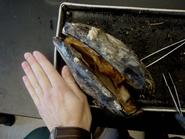
While other folks in tidal regions are eating shellfish this summer, Adele Paquin '07 (Northampton, Mass.) is dissecting hers. Paquin, a biology major specializing in marine biology, has an internship this summer with a graduate student at Sonoma State University in California. She is working on a project which compares the ability of different coastal sites to support populations of mussels and their predator seastars.
Paquin was one of more than 20 Hamiltonians who received college funding to conduct a summer internship. While work experience is becoming more and more necessary for college students, many opportunities are unpaid and require students to pay their own housing and living expenses as well as working for free.
Thanks to alumni and parent donations, Hamilton students can apply for funding to support them while they work in a field of interest with an organization that cannot pay them. Though Paquin works in an unpaid internship, she received a stipend from Hamilton's Joseph F. Anderson Internship Fund, given in honor of a 1944 Hamilton graduate who served the college for 18 years as vice president for communications and development. The fund in his name provides individual stipends to support full-time internships for students wishing to expand their educational horizons in preparation for potential careers after graduation.
This summer Paquin is acting as assistant to Megan Wood, a graduate student in marine biology at Sonoma University. Wood has been awarded a STAR fellowship from the Environmental Protection Agency to do a one-year study on the reproductive output and recruitment of two species in rocky intertidal region of the California coastline.
Wood and Paquin are observing the seastar Pisaster ochraceus, and the mussel upon which it preys, Mytilus californianus. Pisaster is often referred to as a "keystone" species, a species so important in the food-web of the Pacific intertidal that without it, the ecosystem would collapse. Ideally, these data will give Wood information as to why some sites support greater populations of the two species. Her results can, she hopes, aid the EPA as they work to establish new Marine Protected Areas along the coast.
Paquin spends a few days every month on field work, gathering samples and making observations. The rest of her time is lab work, analyzing the sample habitats which are set at four field sites along the coast, and dissecting sample organisms. By dissecting seastars and mussels, Paquin explained, "we can see how much energy they are able to put towards reproduction, which indicates how stressed they are by the environment."
"I've been interested in marine ecology since high school," said Paquin. This is her first experience of summer research, although she has already encountered oceanography fieldwork in her semester with the Sea Education Association (SEA). "The experience this summer is different," Paquin explained, "especially since I am now working in the intertidal, which is a very different habitat than the open ocean." She enjoys working in the new environment; "we get to go out to some sections of the California coast that are absolutely gorgeous," she added.
Paquin, a musician and a cyclist, plans for graduate school and a concentration in some field of marine research. Any advice for aspiring marine biologists or interns? "Find an internship that will really benefit you in the long run," Paquin said.
-- by Lisbeth Redfield
Posted July 2, 2007
